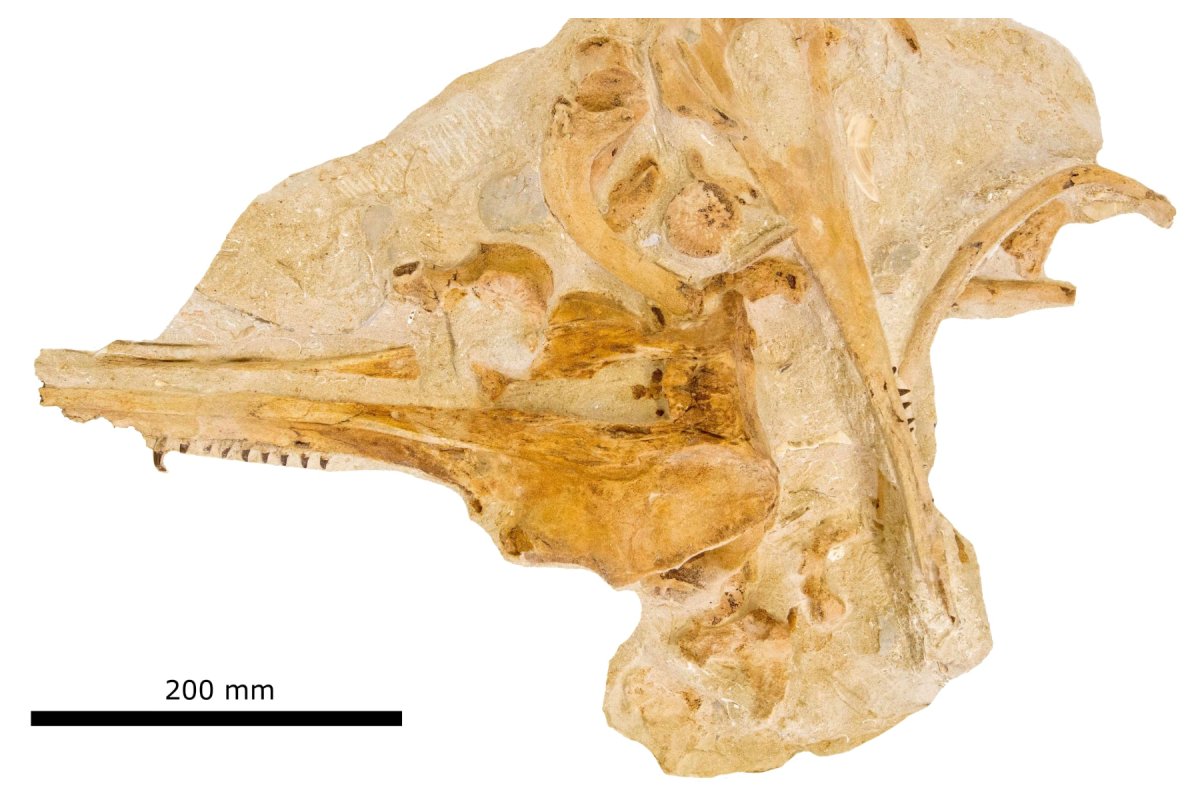A new species of ancient dolphin has been discovered, and it may have had a strange and terrifying way of capturing its prey.
The fossilized creature, named Aureia rerehua, is thought to have lived around 22 million years ago and was discovered in New Zealand.
The dolphin-like fossil is seen to have strange, splayed-out teeth, suggesting that it may have hunted prey by trapping fish in a toothy cage, according to a new paper in theJournal of the Royal Society of New Zealand.
These dolphins are ancient ancestors of modern odontocetes, which are toothed whales. Odontocetes comprise a wide variety of species, ranging from small dolphins like the bottlenose to large whales like the sperm whale. They inhabit various marine environments worldwide, from coastal waters to deep oceans.
Shane Meekin
“Specimen OU22553 [the fossil] includes a skull, teeth, ear bones, mandibles, vertebrae, and ribs,” the authors wrote in the paper. “Specimen OU22553 is the holotype for a new genus and species related to other New Zealand odontocetes, here named Aureia rerehua.
“A. rerehua has an exquisitely preserved skull with a weak vertex and unique lateral tooth orientation, suggesting it scanned shallow waters to capture small prey in a basket of teeth. In addition to providing insights to fossil cetacean feeding methods, A. rerehua and other fossils from the region may clarify the phylogeny of odontocetes related to waipatia [an extinct genus of dolphin from the late oligocene].”
The new species’ name, Aureia rerehua, comes from Māori words referring to the shape of its teeth (aurei/cloak pin), and the quality of its preservation after all these years (rerehua/beautiful).
This dolphin’s strange teeth may have been used similarly to how filter feeders capture their prey today, but on a larger scale, trapping the fish behind a prison of teeth and then sucking them into their maw.
“For comparable examples, teeth in prehistoric marine reptiles like those of Plesiosaurus dolichodeirus, or Metriorhynchus cultridens, are adapted for piercing small or soft prey. Dental orientation in A. rerehua resembles Paludidraco multidentatus or Morturneria seymourensis, fine-toothed, filter feeding reptiles,” the authors wrote.
“Though less tightly packed than the teeth of these filter feeding reptiles, the spaced teeth of A. rerehua might still have caged small fish, innovating a unique feeding strategy among odontocetes.”
The dolphin is also thought to have been capable of echolocation, like its modern-day descendants, which produce high-frequency sounds, which bounce off objects in their environment, allowing them to navigate, locate prey, and communicate with one another.

Shane Meekin
“A. rerehua very likely echolocated, as evidenced by skull asymmetry, auditory
anatomy, and hollow mandibles, but has a weak vertex and premaxillary sac fossae more anteriorly extended than related taxa, shifting nasal sacs and possibly the melon anteroposteriorly. This may mean overlying tissue could spread lower, reducing the vertical profile of A. rerehua,” the authors said.
“However, skull morphology does not necessarily determine head morphology, demonstrated by the flat skulls and the bulbous heads of [beluga whales] or [Amazon river dolphins].”
The dolphin is also thought to have lived and hunted in shallow waters, based on its size.
“Although A. rerehua is likely not fully grown, it is smaller than other immature waipatiid-like odontocetes, and could allow A. rerehua to swim at shallower depths,” the authors explained.
“This could hint A. rerehua scanned seabeds or shallows for small fish as a flexible neck and splayed teeth extended lateral reach at the cost of vertical mobility, netting prey with minimal dental impact,”
Do you have a science story to share with Newsweek? Do you have a question about fossils? Let us know via [email protected]
Uncommon Knowledge
Newsweek is committed to challenging conventional wisdom and finding connections in the search for common ground.
Newsweek is committed to challenging conventional wisdom and finding connections in the search for common ground.


